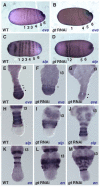giant is a bona fide gap gene in the intermediate germband insect, Oncopeltus fasciatus
- PMID: 20147384
- PMCID: PMC2827692
- DOI: 10.1242/dev.045948
giant is a bona fide gap gene in the intermediate germband insect, Oncopeltus fasciatus
Abstract
Drosophila undergoes a form of development termed long germ segmentation, where all segments are specified nearly simultaneously so that by the blastoderm stage, the entire body plan has been determined. This mode of segmentation is evolutionarily derived. Most insects undergo short or intermediate germ segmentation, where only anterior segments are specified early, and posterior segments are sequentially specified during germband elongation. These embryological differences imply that anterior and posterior segments might rely upon different molecular mechanisms. In Drosophila, embryos mutant for giant show a gap in the anterior as well fusions of several abdominal segments. In Tribolium, a short germ beetle, giant is required for segmental identity, but not formation, in gnathal segments and also for segmentation of the entire abdomen. This raises the possibility that giant might not act as a gap gene in short and intermediate germ insects. Oncopeltus fasciatus is an intermediate germ insect that is an outgroup to the clade containing Drosophila and Tribolium. We cloned the Oncopeltus homolog of giant and determined its expression and function during segmentation. We find that Oncopeltus giant is a canonical gap gene in the maxillary and labial segments and also plays a gap-like role in the first four abdominal segments. Our results suggest that giant was a bona fide gap gene in the ancestor of these insects with this role being lost in the lineage leading towards Tribolium. This highlights the conservation of anterior patterning and evolutionary plasticity of the genetic regulation controlling posterior segmentation, even in short and intermediate germ insects.
Figures








References
-
- Aranda M. (2006). Functional analysis of a homolog of the pair-rule gene hairy in the short-germ beetle Tribolium castaneum PhD thesis, University of Cologne
-
- Brent A. E., Yucel G., Small S., Desplan C. (2007). Permissive and instructive anterior patterning rely on mRNA localization in the wasp embryo. Science 315, 1841-1843 - PubMed
-
- Bucher G., Klingler M. (2004). Divergent segmentation mechanism in the short germ insect Tribolium revealed by giant expression and function. Development 131, 1729-1740 - PubMed
-
- Butt F. H. (1947). Embryology of the milkweed bug Oncopeltus fasciatus (Hemiptera). Cornell Exp. Sta. Mem. 283 1-43
Publication types
MeSH terms
Substances
Grants and funding
LinkOut - more resources
Full Text Sources
Miscellaneous

